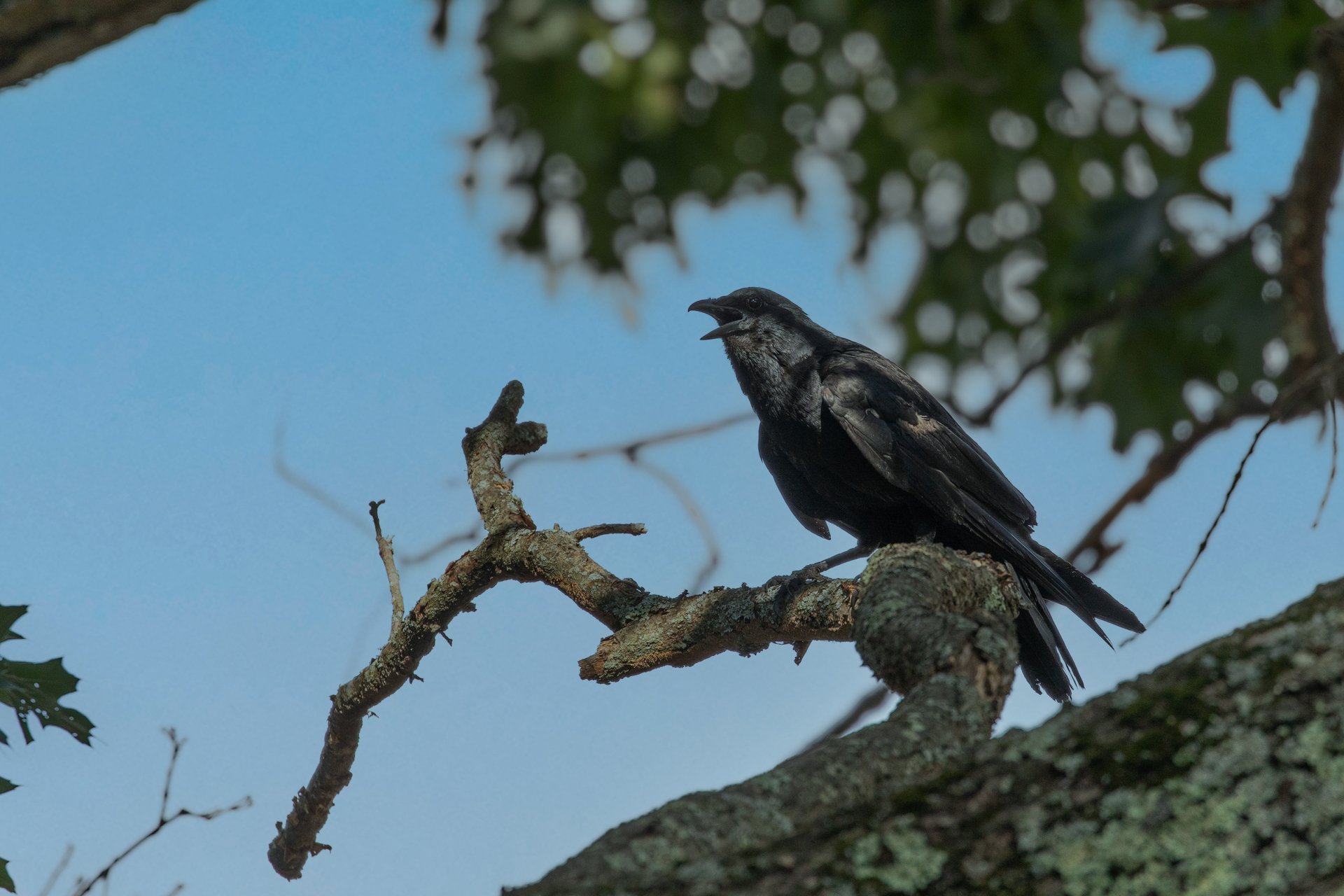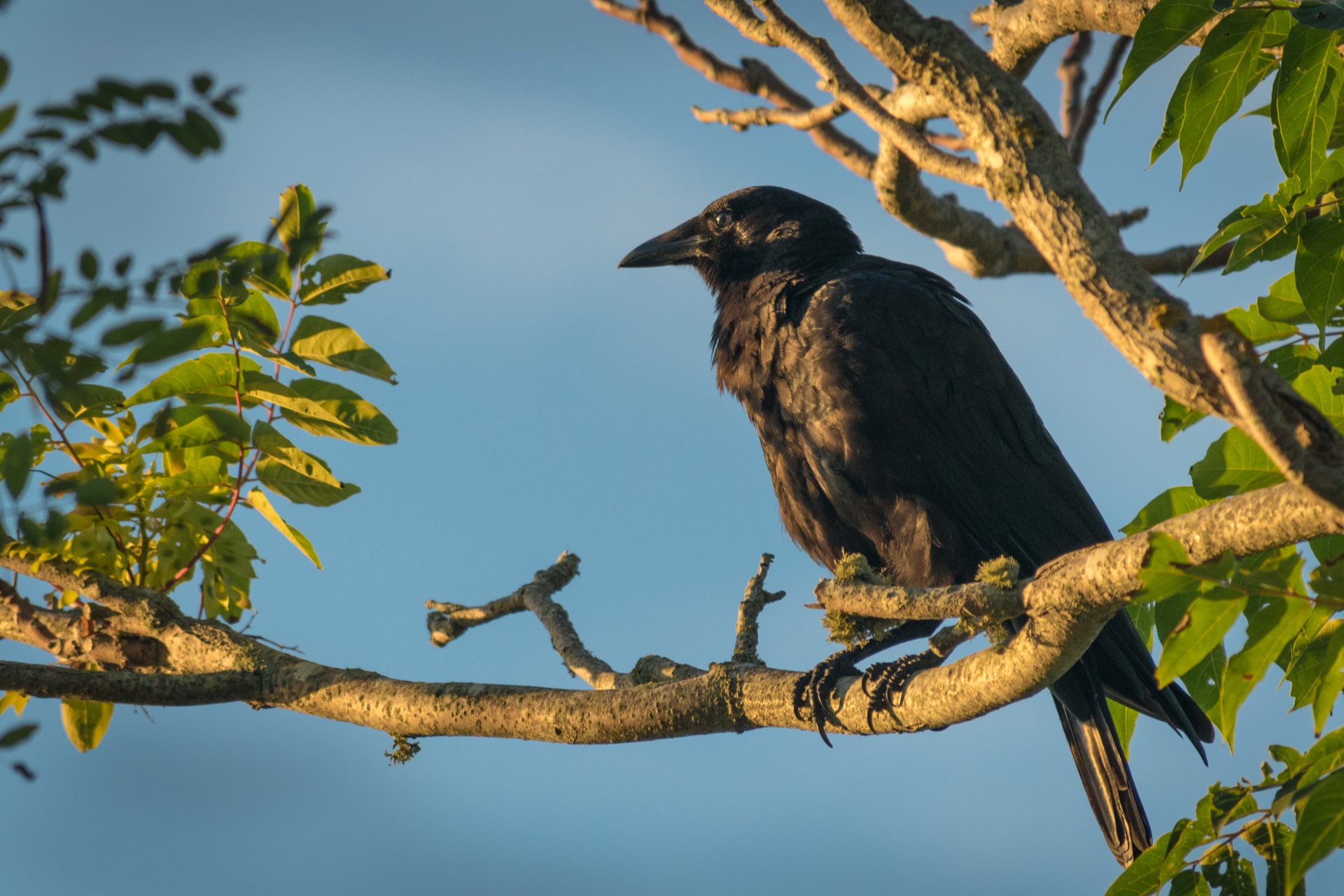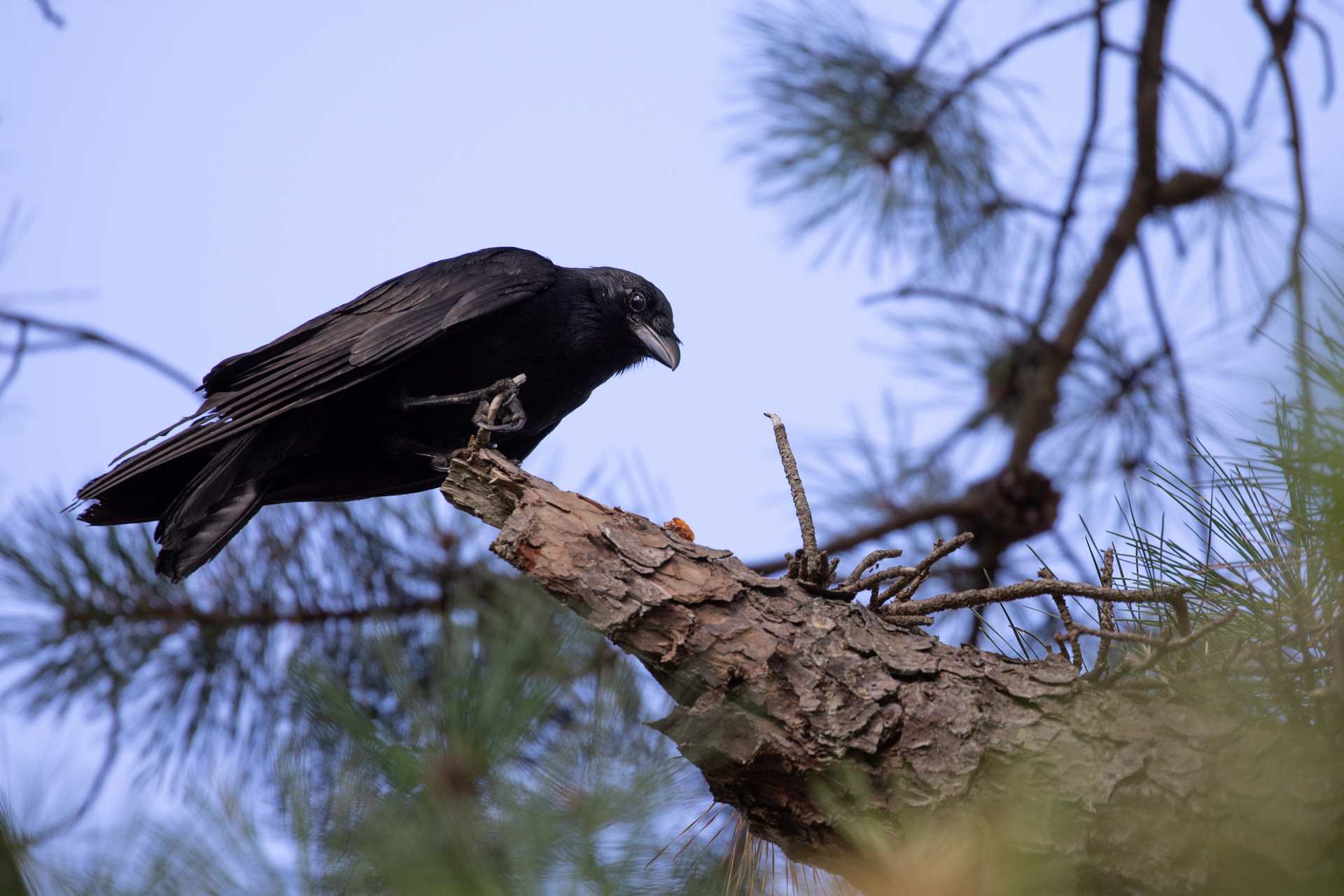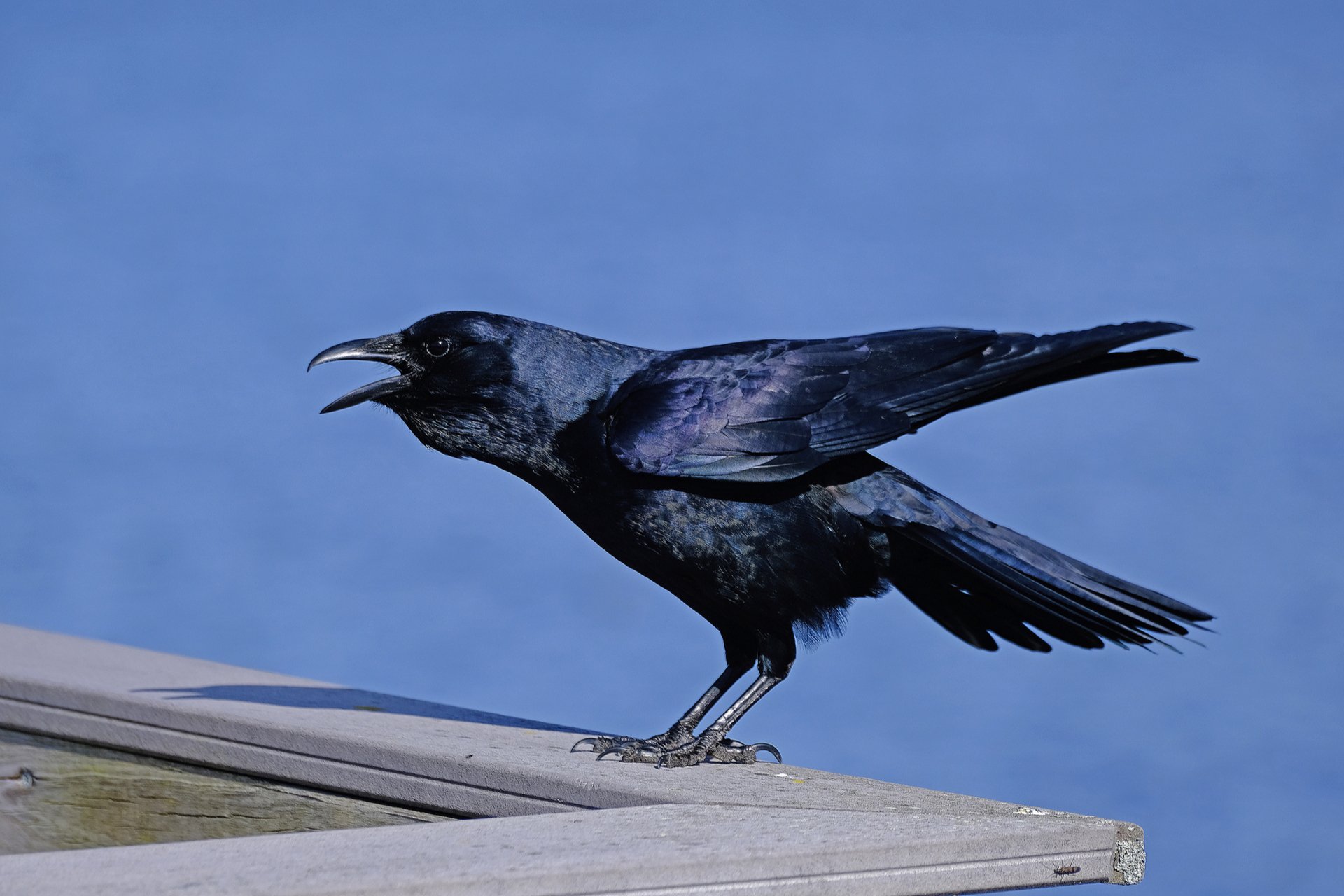Birds in Massachusetts
Crows
Crows have long suffered under the reputation of being "bad." They raid crops, frequently steal eggs and chicks from other bird nests, and have been known to steal shiny objects such as articles of jewelry from people.
Yet, these vocal black birds are among the most intelligent. Crows are said to be able to count (to a point) and they are also known to be very discriminating in their abilities to identify specific objects. Since crows are clever enough to open garbage bags and use our cars to crack open nuts, it is small wonder that these familiar glossy black omnivores have become so common in the Commonwealth.
How to Identify Crows
Crows belong to the family Corvidae, which also includes ravens, magpies, and jays. Two species of crows breed in Massachusetts: the American crow and the fish crow.
The American crow is one of the most familiar birds in the Commonwealth. It is found in both urban and forested areas, in fields and pastures, and along coastal beaches. It’s a large black bird with long legs and a thick bill.
The fish crow is a less common but increasing bird in Massachusetts, where it is near the northernmost part of its range. Nearly identical to the American crow, a fish crow is a little smaller. The best way to distinguish the two is by their call (the fish crow’s is nasal-sounding uh-ugh is very different from the American’s caw).
Crows are often mistaken for similar black birds, including the raven and common grackle. Find out how to distinguish between these similar species
Crow Behavior
Crow Breeding & Nest Building
During late March and April, breeding and nest building begins. Crows begin a number of nests, usually in the crotch of a tall tree, before completing the one that will be used.
Non-breeding young from the previous year, and possibly the year before, stay with the parents to become nest helpers. The number of helpers can vary from 3-6. It is unclear whether or not they help feed the nestlings, but they have been observed aiding in nest building and feeding the incubating female.
In Massachusetts, the eggs are usually laid between early May and mid-June. On average, 3-6 eggs are laid followed by an 18-day incubation period. The young are fed by both parents during the 4-5 week nestling period and are foraging for food on their own two weeks after that.
What Do Crows Eat?
Crows are almost completely omnivorous, meaning they eat a wide variety of food types including fruits, nuts, grains, insects, crustaceans, mollusks, amphibians, reptiles, small mammals, garbage, birds and their eggs and nestlings, and carrion (e.g., roadkills, dead fish, etc.). In residential areas, crows have learned to tear open trash bags placed on the curb prior to rubbish day and to "rototill" lawns in search of grubs.
Crows cache food, meaning they hide food away in niches, nooks, and crannies (such as knotholes in trees) to provide themselves with a ready food supply during food shortages. This behavior also points to the species intelligence, as they must have fairly well-developed memories.
What Do Crows Sound Like?
Crows and their relatives (especially ravens) possess one of the most highly varied vocal repertoires of any group of birds. They are capable of uttering far more than the "caw" call with which many people are most familiar.
This vocal range no doubt accounts for crows' impressive capacity for imitation. Captive birds, particularly, have been known to imitate many sounds including car horns, barking dogs, and human speech.
American Crow Call
Fish Crow Call
Crow Roosts
During non-breeding season from November–March, large groups of American Crows can often be found roosting at night in a stand of trees (deciduous or coniferous). The places crows select for their nightly gatherings can be located anywhere—including within densely populated, residential, or industrial neighborhoods.
Crows will travel up to 50 miles to their night roost, which can contain anywhere from 100-10,000+ individuals. They may also gather in "staging areas" along the route before flying to the roost site just before sunset. A group of crows is called a "murder" of crows.
When in the vicinity of a night roost, anyone looking skyward an hour before sunset may see hundreds of crows arriving at the site from all directions. At morning's first light, the birds begin to noisily communicate with one another before dispersing to their respective foraging areas for the day.
In late February or March, these large roosts begin to break up and the mated pairs disperse to their home territories to begin nest-building. Unmated birds may continue to use the roost for several more weeks.
Other species that roost include European Starlings (late summer), House Sparrows (fall), Red-winged Blackbirds, Brown-headed Cowbirds, Common Grackles, and Chimney Swifts.
How to Evict a Crow Roost
Crows roosting in trees 50 or 60 feet high do not scare off easily. If a roost is causing problems, don’t bother with fake owls or odor repellents—crows are not intimidated by these nonthreatening statues and they don’t have a well-developed sense of smell.
Your best bet to ward off roosting crows is with loud noise. When crows or starlings first arrive at a roost location (usually starting an hour before sunset), a loud, persistent noise might persuade the birds to move on, especially if it is a new roost. Try banging on metal pots and pans or slapping two blocks of wood together.
There are companies that sell recordings of bird distress calls, which may frighten the birds when played. The theory is that when the call of an alarmed crow is played nearby, the crows flying into roost will be frightened off. You will need to change the location of the recorder every few nights so the birds do not get used to it, and it must be played for several hours each evening when the birds begin arriving at the roost site. The success of these devices is questionable, and they are unlikely to discourage a large, long-established communal roost.
Are Crow Roosts Dangerous?
People are often concerned when noisy flocks of hundreds to thousands of crows gather to sleep at night in what’s known as a "roost." But there's no need to worry! Despite Alfred Hitchcock’s portrayal of crows in his movie The Birds, crows are not dangerous.
How Mass Audubon is Supporting Birds in Massachusetts
Mass Audubon works at our wildlife sanctuaries and beyond to ensure that the nature of Massachusetts continues to thrive. By scientifically monitoring Massachusetts birdlife, Mass Audubon informs important conservation decisions and launches targeted initiatives to help at-risk species. In addition, fostering healthy habitats, supporting native species, and educating people about the importance of nature conservation is critical to our success. Learn more about our work
How You Can Support Birds in Massachusetts
Mass Audubon supports birds like the crow every day, but we couldn’t do it without the support of our 160,000+ members.
Help support crows, and birds like them, by becoming a member today.
Upcoming Bird Programs
Destination Birding With a Scone: Rexhame Beach
-
Rexhame Beach, Marshfield
-
Tuesday, January 6
8:00-11:00am
Adults
Wednesday Morning Birding
-
Newburyport and vicinity
-
Wednesday, January 7
9:30am-12:30pm
Adults
Wednesday Morning Birding - Winter
-
Arcadia Wildlife Sanctuary, Easthampton
-
Wednesday, January 7
10:00-11:30am
Adults
Stay Connected
Don't miss a beat on all the ways you can get outdoors, celebrate nature, and get involved.






